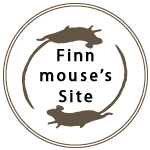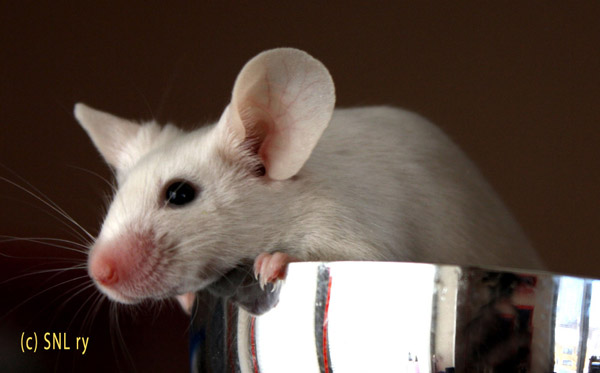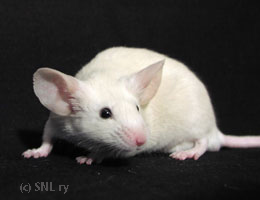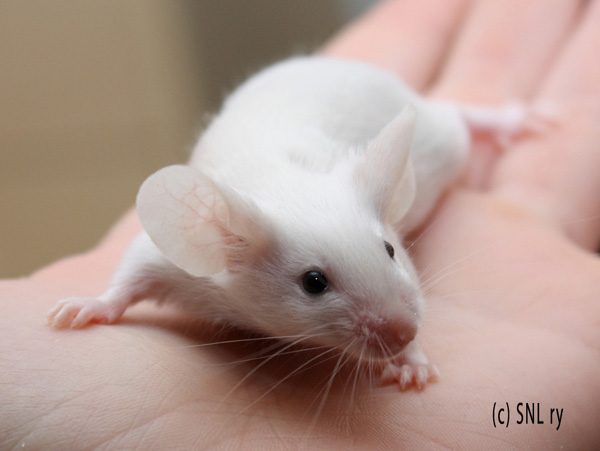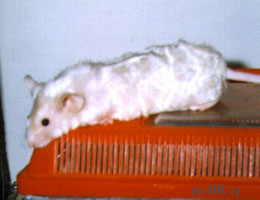Varieties
I - Self
Bone (beb)
a/a B/* ce/c D/* P/*
"Colour to be light, like a bone, not to be confused with Ivory, beige or very diluted champagne. Eye black."
Breeding information below the pictures.
Quick Look
Bone is, together with the PEW, one of the largest mouse varieties, usually having an excellent type as well. This variety is called cream in most mouse standards. BEB should have as excellent a type as PEWs do and this should be taken into account in shows - and in breeding the variety.
Bone is a subtle, light colour. As the name implies, it resembles old bone. Like other c-locus recessive colours, the shades of bone mice can vary considerably and there's the tendency of darkening with age. At its lightest, the BEB can pass for a black eyed white. At its darkest, it looks like too light a beige.
Genetic Background
Genetically speaking, bone is a black mouse with a extreme dilution gene and an albino gene: a/a B/* D/* ce/c P/*, with the correct shade determined by a correct set of modifiers. In other words, bone is a black mouse with extreme dilution ce and c, that is - it is heterozygous in the c-locus. This is why bone does not breed true, but will produce bone, beige and PEW.
The official name of the first gene (in genetic parlance allele) that makes a mouse bone instead of black is "extreme dilution" and it is a spontaneous recessive mutation of "tyrosinase". The official geneticist's symbol is Tyrc-e. The other one is "albino", also a spontaneous recessive mutation of "tyrosinase" and has Tyrc as its official symbol. Both are located in chromosome 7.
The colour of the mouse is changed from black to bone light because the extreme dilution + the albino genes together dilute the black pigment to a colour that is midway of the homozygous forms of both genes in question. That is to say, the colour density is in between that of beige and that of PEW.
In More Practical Terms...
If you're truly interested in keeping the quality of type, size and colour, you should stick to BEB x BEB and BEB x PEW (albino-PEW, not one of the many "pew-impersonators", mice with the pew phenotype but with other than c/c genotype). Mix in other varieties and you'll sooner or later discover that you have a bone of discord at your hands... Unlike with many other varieties, you winners can be born from the first BEB x PEW crosses (given, of course, that the parents are of excellent size and type).
As bone is a heterozygous variety, bone x Bone will bring you not only Bone (1/2), but also beige (1/4) and pink eyed white (1/4).
Beige is a usable outcross, giving both bone and beige in approximately equal amounts. Another possible outcross is colorpoint beige (CPB), producing 1/4 bone, 1/4 beige, 1/4 colorpoint beige and 1/4 himalayan.
If you are forced to look outside the PEW/beige/CPB options, the least destructive option can be black. Using black isn't totally safe, though. Black is a C/* variety and as such it can carry wrong kinds of c-locus recessives. There's no harm, if the other c-locus gene besides C is c, ce is a good thing too, ch will mean you'd have to do a bit of "point removal" breeding, but cch will cause nothing but headache. You should take into consideration that using a black as an outcross can result in loosing size and type of your bones.
The various dilutions of black (blue, chocolate, lilac - for American readers: dove) are better steered clear from, as are all the pink eyed varieties. Even though both ce and c are usually linked with black eyes (P), linkage with the pink eye gene p isn't unheard of. If you manage to get those in your lines, your bones will suddenly start throwing pretty much only "PEW".
Word of advice for those thinking about using ticked or silver-ticked varieties for outcross: forget it. Neither party will benefit from that kind of combination. Even though I'm not advocating the use of alcohol, here's a comparison: if you're interested in wilfully getting a headache, one you can get from the nearest bar will be over easier than the one you get from mixing in A, cch or silver-ticking into bones, or adding ce into ticked or silver-ticked varieties.
You can read about the (un)suitability of the Ay varieties from the beige article. The same rules apply for bone.
Starting From Scratch?
If the local mouse scene looks sadly bone-less, you will have to get both ce and c from one source or another. The first one is most easily obtainable from beige and if you can get your hands on a c/c PEW, the solution is easy. Beige x PEW produces a whole litter of bone. Other possibilities include beige x himalayan (producing colorpoint beige and bone), colorpoint beige x PEW (bone, CPB, himalayan), colorpoint beige x himalayan (CPB, siamese, bone and himalayan).
Hey! You Forgot the Pink Eyed Bone!
No, I didn't. Can't say I didn't try, though...
The most likely reason the pink eyed bone (PEB) is in the standards is that it's a relic from times when the standard was called cream and even then it was somewhat a relic from times when the genotype was that of present straw. As it isn't quite clear what kind of genotype would bring a mouse with a phenotype fitting the PEB standards, the PEB has been removed from standardized status.
